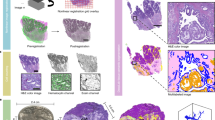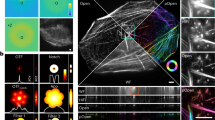Abstract
We present a method for the computational reconstruction of the 3-D morphology of biological objects, such as cells, cell conjugates or 3-D arrangements of tissue structures, using data from high-resolution microscopy modalities. The method is based on the iterative optimization of Voronoi representations of the spatial structures. The reconstructions of biological surfaces automatically adapt to morphological features of varying complexity with flexible degrees of resolution. We show how 3-D confocal images of single cells can be used to generate numerical representations of cellular membranes that may serve as the basis for realistic, spatially resolved computational models of membrane processes or intracellular signaling. Another example shows how the protocol can be used to reconstruct tissue boundaries from segmented two-photon image data that facilitate the quantitative analysis of lymphocyte migration behavior in relation to microanatomical structures. Processing time is of the order of minutes depending on data features and reconstruction parameters.
This is a preview of subscription content, access via your institution
Access options
Subscribe to this journal
Receive 12 print issues and online access
$259.00 per year
only $21.58 per issue
Buy this article
- Purchase on Springer Link
- Instant access to full article PDF
Prices may be subject to local taxes which are calculated during checkout







Similar content being viewed by others
References
Stoll, S., Delon, J., Brotz, T.M. & Germain, R.N. Dynamic imaging of T cell-dendritic cell interactions in lymph nodes. Science 296, 1873–1876 (2002).
Germain, R.N. et al. An extended vision for dynamic high-resolution intravital immune imaging. Semin. Immunol. 17, 431–441 (2005).
Xu, X., Meier-Schellersheim, M., Yan, J. & Jin, T. Locally controlled inhibitory mechanisms are involved in eukaryotic GPCR-mediated chemosensing. J. Cell Biol. 178, 141–153 (2007).
Couteau, B., Payan, Y. & Lavallee, S. The mesh-matching algorithm: an automatic 3D mesh generator for finite element structures. J. Biomech. 33, 1005–1009 (2000).
Lorensen, W.E. & Cline, E.C. Marching Cubes: a high resolution 3D surface construction algorithm. Comput. Graph. 21, 163–169 (1987).
Bootsma, G.J. & Brodland, G.W. Automated 3-D reconstruction of the surface of live early-stage amphibian embryos. IEEE Trans. Bio-Med. Eng. 52, 1407–1414 (2005).
Yu, X. et al. A novel biomedical meshing algorithm and evaluation based on revised Delaunay and Space Disassembling. Conf. Proc. IEEE Eng. Med. Biol. Soc. 2007, 5091–5094 (2007).
Baker, T.J. Mesh generation: art or science? Progress in Aerospace Sciences 41, 29–63 (2005).
Qi, H., Cannons, J.L., Klauschen, F., Schwartzberg, P.L. & Germain, R.N. SAP-controlled T–B cell interactions underlie germinal centre formation. Nature 455, 764–769 (2008).
Voronoi, G. Nouvelles applications des paramètres continus à la théorie des formes quadratiques. J. Reine. Angew. Math. 133, 97–178 (1907).
Lopreore, C.L. et al. Computational modeling of three-dimensional electrodiffusion in biological systems: application to the node of Ranvier. Biophys. J. 95, 2624–2635 (2008).
Dirichlet, G.L. Über die Reduktion der positiven quadratischen Formen mit drei unbestimmten ganzen Zahlen. J. Reine. Angew. Math. 40, 209–227 (1850).
Aurenhammer, F. Voronoi diagrams—a survey of a fundamental geometric data structure. ACM Computing Surveys 23, 345–405 (1991).
Coggan, J.S. et al. Evidence for ectopic neurotransmission at a neuronal synapse. Science 309, 446–451 (2005).
Kholodenko, B.N. Cell-signalling dynamics in time and space. Nat. Rev. 7, 165–176 (2006).
Lizana, L., Konkoli, Z., Bauer, B., Jesorka, A. & Orwar, O. Controlling chemistry by geometry in nanoscale systems. Annu. Rev. Phys. Chem. 60, 449–468 (2009).
Neves, S.R. et al. Cell shape and negative links in regulatory motifs together control spatial information flow in signaling networks. Cell 133, 666–680 (2008).
Jones, W.P. & Menzies, K.R. Analysis of the cell-centred finite volume method for the diffusion equation. J. Comput. Phys. 165, 45–68 (2000).
Germain, R.N. et al. Making friends in out-of-the-way places: how cells of the immune system get together and how they conduct their business as revealed by intravital imaging. Immunol. Rev. 221, 163–181 (2008).
Schwickert, T.A. et al. In vivo imaging of germinal centres reveals a dynamic open structure. Nature 446, 83–87 (2007).
Allen, C.D., Okada, T., Tang, H.L. & Cyster, J.G. Imaging of germinal center selection events during affinity maturation. Science 315, 528–531 (2007).
Hauser, A.E. et al. Definition of germinal-center B cell migration in vivo reveals predominant intrazonal circulation patterns. Immunity 26, 655–667 (2007).
Acknowledgements
This research was supported by the Intramural Research Program of NIAID, NIH.
Author information
Authors and Affiliations
Corresponding authors
Rights and permissions
About this article
Cite this article
Klauschen, F., Qi, H., Egen, J. et al. Computational reconstruction of cell and tissue surfaces for modeling and data analysis. Nat Protoc 4, 1006–1012 (2009). https://doi.org/10.1038/nprot.2009.94
Published:
Issue Date:
DOI: https://doi.org/10.1038/nprot.2009.94
This article is cited by
-
DNA copy number changes define spatial patterns of heterogeneity in colorectal cancer
Nature Communications (2017)
-
Setup and use of a two-laser multiphoton microscope for multichannel intravital fluorescence imaging
Nature Protocols (2011)
Comments
By submitting a comment you agree to abide by our Terms and Community Guidelines. If you find something abusive or that does not comply with our terms or guidelines please flag it as inappropriate.



